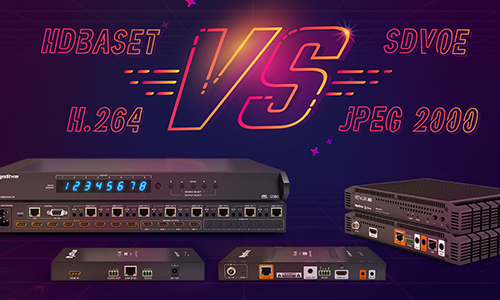by James Meredith
 The launch of several new technology platforms, as well as feature updates and price reductions to existing technologies, will further improve the quality and functionality of the hardware on offer. There is an exciting year ahead and we have all the tools to create some truly innovative systems that will thrill and amaze users the world over.
The launch of several new technology platforms, as well as feature updates and price reductions to existing technologies, will further improve the quality and functionality of the hardware on offer. There is an exciting year ahead and we have all the tools to create some truly innovative systems that will thrill and amaze users the world over.
The current market leader for distance signal extension is Valens’ HDBaseT technology; its market share is significant and shows no sign of residing in 2020. The most common VS010 (often called Class B) and VS100 (Class A) platforms offer excellent value for content up to 4K 4:4:4 @ 30Hz at either 40 or 70 meters. The ability to power either the TX or RX (2-way POH) and pass control and 10/100Mb/s network data (only VS100 supports Ethernet) means they are ideally suited for point-to-point applications. The lack of configuration, except for the occasional EDID learn, is what really makes HDBaseT stand out from the crowd. However, stretching to 4:4:4 @ 60Hz requires compression. VESA’s DSC compression is HDBaseT’s preferred choice for its 2.0 chipset, and this provides excellent “visually lossless” tipping point compression.
To transmit HDBaseT without compression, fiber optics are useful to increase the bandwidth and enable the transfer of the full 18Gb/s bandwidth required for HDMI 2.0 content. From HDBaseT over fiber, Active HDMI fiber cables, or more proprietary solutions, these can be cost effective if running dedicated fiber lines is a possibility. Of course, the added benefit of fiber transmission is its immunity from RF and EM interference, meaning transmission distances can go way beyond the limits of copper.
In 2016, Valens announced HDBaseT 2.0 (the VS2xxx chipset) which further extended the transmission distance up to 100 meters while adding USB 2.0 transfer. This has been a welcome addition for IT centric environments but not a “must have” for most installations. HDBaseT will get a major revision in 2020 with the launch of version 3.0 that will allow uncompressed 4K 4:4:4 @ 60Hz up to 100 meters. Coupled with the existing features of today’s HDBaseT technology and the new addition of 1Gb Ethernet, this is a major step forward for the platform. But HDBT will not be alone.
SDVoE from AptoVision has positioned itself as the key competitor to HDBaseT—and for good reason. Presently, the SDVoE platform is the only way to send lossless 4K 4:4:4 @ 60Hz over category cable with almost all of the same features as HDBaseT, but rather than point-to-point, it does so over the network. There is no doubt that AV over IP is here to stay, and it is all because of its flexibility. In my previous article, I discussed the benefits in more detail but to summarize: the modularity of the technology means that systems of any size can be designed and added to with almost completely linear cost increments, unlike HDBaseT with its matrix centric design.
SDVoE significantly outclasses today’s HDBaseT features, already supporting lossless 4K 4:4:4 @ 60Hz with 1Gb Ethernet but it does so at a cost, although these costs have significantly reduced this year and will continue to do so. This is due to wider adoption driving down prices of 10Gb hardware. But its wider adoption will not have a significant impact on its market share until AptoVision’s purchase by Semtech bares fruit in the form of the AVX ASIC. This will dramatically reduce the cost of the SDVoE technology, so 2020 will be SDVoE’s break-through year.
Of course, SDVoE is not the only AV over IP solution on the market. A range of 1Gb solutions exist and, when combined, make up the majority of the AV over IP market. The reason being that 1Gb Ethernet has been the industry standard for some time and will continue to be for the short term. But this means one thing… compression. Be it H.264/H.265, JPEG2000 or a proprietary format based loosely on one of the above, compression is a necessary evil. With a 1080p stream using anything up to 6Gb/s of data, and HDMI 2.0 4K maxing out at 18Gb/s—8:1 “visually lossless” and 20:1 “not so visually lossless” compression is a must to reduce the data into something that will fit down the pipe.
In WyreStorm’s experience however, this lossy compression is something that the many end users are willing to accept. This proves that “good enough” video quality and getting the best value for their money are both important to end users for most systems. This is why WyreStorm has for many years hosted a shootout of our core technologies on our tradeshow booth, enabling the market to see for itself the differences between Coke, Pepsi and own brand cola. The quality of these 1Gb solutions is also set to increase in 2020 with multiple venders releasing updated platforms focusing on support for 4K 4:4:4 @ 60Hz, reduced latency and ARC. But few have yet defined their final specifications, like HDBaseT, so watch out for news at Infocomm in June.
Like HDBaseT, the AVoIP technologies above offer control, data and power functionality although they tend to be slightly different in operation. Control data can be IR, RS-232 or CEC passthrough like HDBT but could also be rendered from an IP command effectively making every end point an extension to the control system processor. Power, rather than being passed from TX to RX or encoder to decoder, is POE from the switch. These
differences make sense in the context of the network but also give AVoIP devices an edge against a fixed matrix system design.
However, the undeniable fact remains that AV over IP is not plug and play like HDBaseT. WyreStorm, SDVoE, and switch companies like Netgear have done a great job of preconfiguring switches, enabling close to plug and play operation in a select few environments, but whenever a larger network is involved there are IP addresses to set and network hardware to configure. WyreStorm offers first class documentation and support to make this easier but IT administrators tend to live in a different world to us AV folks. Sometimes, these worlds clash with unexpected or even painful results. In certain scenarios no matter what level of security your products offer or what certifications you have, an endpoint on the network is a security risk that cannot be tolerated.
2020 will be the year that HDBaseT and SDVoE really battle it out on a more even playing field to vie for market dominance. Resolution, color depth and HDR format support, latency, and most importantly price will all be relatively aligned for the first time. So, what will make one stand out above the other? To my mind the additional features of AV over IP, like video wall and particularly multi-view with Picture in Picture, will be key deciders. That is where SDVoE has the edge. It’s going to be a great year and WyreStorm has more products in the pipeline than ever before to take advantage of these key advancements.
If you have yet to dip your toes into the world of AV over IP, I suggest reading my previous article to see why now is a great time to expand your horizons and product offerings. For information on all these technologies and more, please visit wyrestorm.com.




